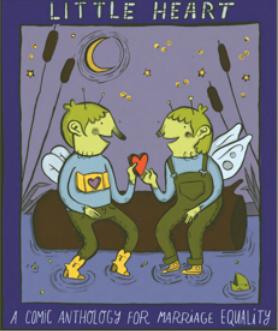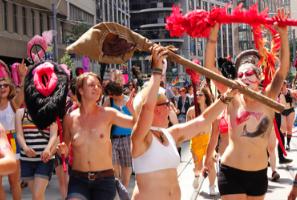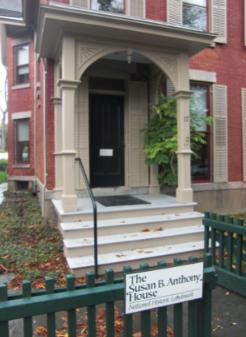
One of Wickedly Sent's cheeky products. Credit: Danny Glenwright

The Pittsford canal near Rochester. Credit: Danny Glenwright

Local grapes for sale at Rochester's public market. Credit: Danny Glenwright
Well, golly gee whiz, Rochester ain’t so bad after all.
A three-hour drive, a border crossing and one very strong American accent away from Toronto, it’s no longer the city Torontonians have loved to hate.
Back in 2003, The Globe and Mail’s Jan Wong famously tore Rochester to shreds in an article called “Ferry Bad Place.”
At the time, Wong visited the post-industrial city on the south shore of Lake Ontario prior to the launch of a Rochester-Toronto car ferry, listing “several important reasons why Torontonians wouldn’t want to come here.”
Wong’s excoriation was helped along by the city’s then-mayor, who happily offered up Rochester’s startling crime statistics and even chastised Wong for walking the dangerous streets of his city.
If boosterism wasn’t a Rochester trait back then, it is now.
Indeed, it is hard to find anyone in Rochester who isn’t prepared to tell you how wonderful Rochester is.
It is the city, say locals, where everything from baby shoes to Kodak to gelatin was invented. And while some of these assertions may seem dubious (not to mention rather unexciting), it is not a stretch to mention Rochester’s current reinvention.
Great food, appealing arts and culture, and a thriving queer community make it a far better weekend destination than Niagara Falls or Buffalo and well worth the extra time on the highway. Crime rates have also plummeted in recent years.
Over three days in the city locals call quaint, it is obvious, however, that Wong’s article and its fallout (the Toronto-Rochester ferry stopped running in 2006) still rankle.
Yet in a way the bullying has changed Rochester for the better. It’s given locals a renewed sense of service and helped launch a determined, bullish tourism industry responsible for a mushrooming of local shops, markets and events.
Rochester is a foodie’s dream, kitted out with organic, fresh, local and free-range options in every neighbourhood. Contrasting what we Canadians may imagine of our southern neighbours, Rochester folks seem to be fit, healthy and actively embracing the local food revolution.
Free-range local eggs are an option for all breakfast dishes at Jines Restaurant, a long-running hotspot in the trendy Park Ave neighbourhood. For those who would rather indulge a sweet tooth, the pumpkin pancakes and stuffed French toast are tempting options.
Lunchtime to-go fare is even better at Wegmans, a mix between Whole Foods and the uptown Pusateri’s (without the roaches) but with greater variety than both. But Rochester’s best food option is the public market, which boasts dozens of yummy stalls and restaurants, selling everything from fair-trade coffee to kettle corn. The cute local farmhands are an added bonus.
Upstate New York is home to the Finger Lakes region, a series of thin, north-south oriented bodies of water. The region, just south of Rochester, is famous for its wine, with more than 100 wineries producing some of North America’s tastiest chardonnays and rieslings.
The New York Wine and Culinary Center in nearby Canandaigua is the best place to sample the region’s grapes. Visitors should also check out F Oliver’s oil and vinegars on Canandaigua’s Main St. The shop sells more than 30 varieties of locally produced flavoured oils and balsamics, including sage, wild mushroom and ripe fig.
Gay-owned Wickedly Sent is Canandaigua’s bath and body shop. Partners Scott Mackey and Don Stevens sell soaps, lotions and candles, with some cheeky products, like their “Dirty Dyke” soap, marketed to the area’s burgeoning gay tourist market.
And that’s the best part about Rochester: it actually is a living, breathing, even desirable gay and lesbian destination. The 2000 US census found that Rochester has approximately 60 percent more gay males and lesbians than the national average.
It is easy to while away an evening at one of Rochester’s several gay bars, especially 140 Alex Bar and Grill, which offers dancing, karaoke and better drag shows than most Church St haunts.
The city’s annual ImageOut lesbian and gay film festival has been growing since it began in 1993, and Rochester’s July Pride celebration is the second largest in the state after Manhattan’s. It’s also worth noting that Rochester’s mayor participates in both events.
“We have a long history of inclusion here,” says Sue Cowell, a local lesbian activist and Pride staffer. “It’s sort of in the DNA.”
Considering the city’s history, this is one claim that is not hard to believe. Rochester’s two most famous citizens are both remembered for their progressive streaks.
Susan B Anthony was a prominent civil rights leader and one of the first in the fight for women’s suffrage in the United States. Her home in downtown Rochester is worth a visit.
Meanwhile, George Eastman not only invented roll film and Kodak, he gave millions to support the education of black youth. Eastman’s Rochester mansion is now a fascinating museum housing one of the world’s largest collections of film and photography.
Interestingly, neither Eastman nor Anthony ever married or had kids, and local gays have long suspected these two trailblazers were team members.
There may, in fact, be more than a little gay in Rochester DNA after all.
Either way, like many gays, Rochester has rebounded from years of bullying and finally come of age. There is no longer a ferry connecting it to Toronto, but Rochester is increasingly a fairy nice place to visit.


 Why you can trust Xtra
Why you can trust Xtra